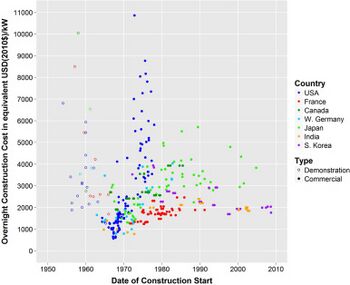Cost of nuclear power: Difference between revisions
(→Hydrogen:: add data on costs) |
(→Cost of alternatives: add discussion of capacity factor and load following) |
||
| Line 8: | Line 8: | ||
== Cost of alternatives == | == Cost of alternatives == | ||
Capacity Factor (CF) is often ignored in discussions of intermittent sources like wind and solar. A typical rooftop solar panel system with a nameplate rating of 12 kW and a sunny climate in the Arizona desert will deliver 10 kW peak and 3 kW average over a year. A realistic cost per kW is therefore four times the often quoted cost. This does not include the cost of batteries, or any other storage that might be necessary for a regional utility. Storage is not necessary for rooftop systems, if the utility can provide full credit for power returned to the grid. The challenge for the utility is load following. If the fraction of total power on the grid from intermittent sources is too large, there will be extra expense for batteries or generators held as "spinning reserve" for rapid response when the intermittents drop out. | |||
===Rooftop Solar (no batteries):=== | ===Rooftop Solar (no batteries):=== | ||
$2,900 per kW (nameplate), $11,600 per kW avg (25% Capacity Factor)<br> | $2,900 per kW (nameplate),<ref>Quote from a solar panel installer in Arizona.</ref> $11,600 per kW avg (25% Capacity Factor)<br> | ||
===Wind Turbines=== | ===Wind Turbines=== | ||
$770–$850 per kW (nameplate), down from $1800 in 2008.<ref>[https://www.energy.gov/articles/doe-releases-new-reports-highlighting-record-growth-declining-costs-wind-power DOE report 30 Aug 2021]</ref><br> | $770–$850 per kW (nameplate), down from $1800 in 2008.<ref>[https://www.energy.gov/articles/doe-releases-new-reports-highlighting-record-growth-declining-costs-wind-power DOE report 30 Aug 2021]</ref><br> | ||
Revision as of 11:05, 22 August 2022
Historical Costs
see Fig.1
Cost of new designs
ThorCon MSR:
$1200 per kW + $0.03 per kWh [2]
Cost of alternatives
Capacity Factor (CF) is often ignored in discussions of intermittent sources like wind and solar. A typical rooftop solar panel system with a nameplate rating of 12 kW and a sunny climate in the Arizona desert will deliver 10 kW peak and 3 kW average over a year. A realistic cost per kW is therefore four times the often quoted cost. This does not include the cost of batteries, or any other storage that might be necessary for a regional utility. Storage is not necessary for rooftop systems, if the utility can provide full credit for power returned to the grid. The challenge for the utility is load following. If the fraction of total power on the grid from intermittent sources is too large, there will be extra expense for batteries or generators held as "spinning reserve" for rapid response when the intermittents drop out.
Rooftop Solar (no batteries):
$2,900 per kW (nameplate),[3] $11,600 per kW avg (25% Capacity Factor)
Wind Turbines
$770–$850 per kW (nameplate), down from $1800 in 2008.[4]
$3240 per kW avg (25% Capacity Factor)
Batteries:
Lead-Acid: $300 per kWh
Li-ion:
Hydrogen:
Worldwide hydrogen production stood at 90 Mt in 2020, but since it was produced almost exclusively from fossil fuels, the result was close to 900 Mt of CO2 emissions.[5]
"Green" hydrogen (no CO2) can be produced from water using electrolysis, but the cost is much higher.[6]
$2 per kg promised by mid 2020s[7]
$1 per kg ten-year goal set by DOE[8]
$0.12 per kWh electrical energy storage cost, assuming $2 per kg of H2, and 50% overall efficiency.[9]
Notes and References
- ↑ Fig.12 in Lovering 2016 "Historical construction costs of global nuclear power reactors" https://doi.org/10.1016/j.enpol.2016.01.011
- ↑ ThorCon's estimate of costs.
- ↑ Quote from a solar panel installer in Arizona.
- ↑ DOE report 30 Aug 2021
- ↑ See the section "Hydrogen supplies are becoming cleaner … too slowly" in the IEA Global Hydrogen Review 2021.
- ↑ Depending on regional gas prices, the levelized cost of hydrogen production from natural gas ranges from $0.50 to $1.70 per kg. See the section "Low-carbon hydrogen can become competitive within the next decade" in the IEA Global Hydrogen Review 2021.
- ↑ Australian company Hysata, PV Magazine, Aug 2022.
- ↑ Department of Energy's "Hydrogen Shot"
- ↑ Energy density of H2 is 33 kWh/kg. ($2/kg / 33 kWh/kg / 50%) = $0.12/kWh.
